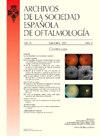Isquemia macular tras perforación inadvertida del globo ocular e inyección intravítrea de anestésicos durante una anestesia retrobulbar
Q3 Medicine
Archivos De La Sociedad Espanola De Oftalmologia
Pub Date : 2025-10-01
DOI:10.1016/j.oftal.2025.05.003
引用次数: 0
Abstract
Perforation of the eyeball during retrobulbar anesthesia is rarely reported. A case of inadvertent ocular perforation during retrobulbar anesthesia in cataract surgery is presented. Retinal complications and follow up after six months are described.
A 58-year-old man presented with vision loss following cataract surgery on his right eye by phacoemulsification and intraocular lens implantation under retrobulbar anaesthesia performed one week earlier. Visual acuity was 0.05. Fundus examination revealed a vitreous haemorrhage in the lower area. A rounded haemorrhage was present next to the lower temporal arcade with a possible entry orifice. Optical coherence tomography, tomographic angiography and fluorescein angiography showed retinal ischaemia in the juxtapapillary macular area.
The patient was followed for 6 months. Visual acuity improved to 0.5. Optical coherence tomography and tomographic angiography showed a reduction of the edema in the retinal layers, with a persistent loss of the inner nuclear and outer plexiform layer
Accidental intravitreal injection of bupivacaine and lidocaine during retrobulbar anaesthesia can result in permanent visual impairment. Extreme attention should be paid to the injection technique to avoid this complication.
在回缩麻醉过程中,无意中刺穿眼球和静脉注射麻醉剂后的黄斑缺血
球后麻醉时眼球穿孔的报道很少。本文报告一例白内障手术中球后麻醉时不慎发生眼穿孔的病例。描述了视网膜并发症和六个月后的随访情况。一名58岁男性于一星期前接受右眼白内障手术,经超声乳化术及球后麻醉下人工晶状体植入术后出现视力丧失。视力0.05。眼底检查显示下区玻璃体出血。颞骨下拱廊旁有圆形出血,可能有进入口。光学相干断层扫描,断层血管造影和荧光素血管造影显示视网膜缺血在乳头旁黄斑区。随访6个月。视力提高到0.5。光学相干断层扫描和断层血管造影显示视网膜层水肿减少,内核层和外丛状层持续丢失。球后麻醉期间意外地在玻璃体内注射布比卡因和利多卡因可导致永久性视力损害。应特别注意注射技术,以避免这种并发症。
本文章由计算机程序翻译,如有差异,请以英文原文为准。
求助全文
约1分钟内获得全文
求助全文
来源期刊

Archivos De La Sociedad Espanola De Oftalmologia
Medicine-Ophthalmology
CiteScore
1.20
自引率
0.00%
发文量
109
审稿时长
78 days
期刊介绍:
La revista Archivos de la Sociedad Española de Oftalmología, editada mensualmente por la propia Sociedad, tiene como objetivo publicar trabajos de investigación básica y clínica como artículos originales; casos clínicos, innovaciones técnicas y correlaciones clinicopatológicas en forma de comunicaciones cortas; editoriales; revisiones; cartas al editor; comentarios de libros; información de eventos; noticias personales y anuncios comerciales, así como trabajos de temas históricos y motivos inconográficos relacionados con la Oftalmología. El título abreviado es Arch Soc Esp Oftalmol, y debe ser utilizado en bibliografías, notas a pie de página y referencias bibliográficas.
 求助内容:
求助内容: 应助结果提醒方式:
应助结果提醒方式:


